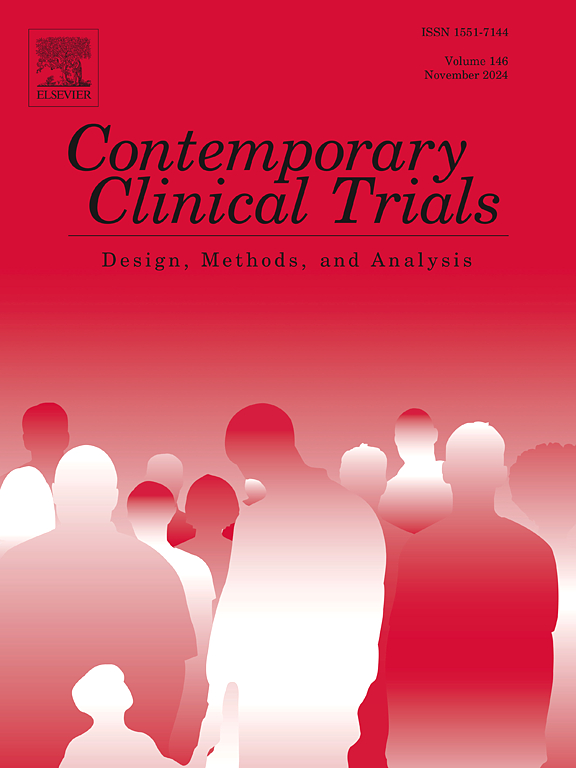设计一个集群随机多级干预,以减少少数癌症患者转诊和入组癌症临床试验的障碍:ACT WONDER2S研究。
IF 1.9
3区 医学
Q3 MEDICINE, RESEARCH & EXPERIMENTAL
引用次数: 0
摘要
由于患者、医生和系统层面的障碍,非西班牙裔(NH)黑人/非裔美国人(AA)和西班牙裔癌症患者在癌症临床试验(cct)中的代表性不足。因此,多层次的方法对于解决有条件现金援助参与的障碍至关重要。本文介绍了ACT WONDER2S的研究设计和基线特征,这是一项多层次干预(MLI),旨在减少NH黑人/AA和西班牙裔患者转诊和入组cct的障碍。方法:ACT WONDER2S是一个MLI,包括社区外展和数字干预,面向社区和莫菲特癌症中心(MCC)人群。地理空间分析用于确定具有高NH黑人/AA和西班牙裔人口的人口普查区(“优先区域”)集群,以进行干预部署。然后根据人群特征匹配优先区域,并随机分配接受干预(n = 7)或作为对照组(n = 7)。使用美国人口普查数据和其他公共资源描述了优先区域的基线特征。结果:大约16.5% %和35.8% %的干预优先区分别是NH黑人/AA或西班牙裔。在总体规模(配对t检验p值 = 0.63)、NH黑人/AA的比例(p = 0.13)和西班牙裔人群(p = 0.17)或距离MCC的英里数(p = 0.64)方面,组间无统计学显著差异。估计的癌症病例数和CCT基线登记率在两组之间也相似。结论:如果ACT WONDER2在增加NH黑人/AA和西班牙裔癌症患者的CCT转诊和入组方面有效,那么ACT WONDER2可以在其他地理环境中部署,从而减少全国范围内CCT转诊和入组的差异。本文章由计算机程序翻译,如有差异,请以英文原文为准。
Design of a cluster randomized multi-level intervention to decrease barriers to minority cancer patient referral and enrollment to cancer clinical trials: The ACT WONDER2S study
Introduction
Non-Hispanic (NH) Black/African American (AA) and Hispanic cancer patients are underrepresented in cancer clinical trials (CCTs) due to patient, physician, and system-level barriers. Therefore, multi-level approaches are critical to address barriers to CCT participation. Presented here are the study design and baseline characteristics of ACT WONDER2S, a multi-level intervention (MLI) aimed to decrease barriers to NH Black/AA and Hispanic patient referral and enrollment in CCTs.
Methods
ACT WONDER2S is an MLI including community outreach and digital interventions for community and Moffitt Cancer Center (MCC) populations. Geospatial analytics were used to identify clusters of census tracts (“priority zones”) with high NH Black/AA and Hispanic populations for intervention deployment. Priority zones were then matched on population characteristics and randomized to receive the intervention (n = 7) or to serve as controls (n = 7). Baseline characteristics of the priority zones were described using US Census data and other public sources.
Results
Approximately 16.5 % and 35.8 % of the intervention priority zones are NH Black/AA or Hispanic, respectively. There are no statistically significant differences between groups in total population size (paired t-test p-value = 0.63), proportions of NH Black/AA (p = 0.13) and Hispanic populations (p = 0.17), or distance in miles from MCC (p = 0.64). The estimated number of cancer cases and CCT enrollment rates at baseline are also similar between groups.
Conclusion
If shown to be effective in increasing referral and enrollment of NH Black/AA and Hispanic cancer patients to CCTs, ACT WONDER2)S can be deployed across other geographic settings, thereby reducing disparities to CCT referral and enrollment on a national scale.
求助全文
通过发布文献求助,成功后即可免费获取论文全文。
去求助
来源期刊
CiteScore
3.70
自引率
4.50%
发文量
281
审稿时长
44 days
期刊介绍:
Contemporary Clinical Trials is an international peer reviewed journal that publishes manuscripts pertaining to all aspects of clinical trials, including, but not limited to, design, conduct, analysis, regulation and ethics. Manuscripts submitted should appeal to a readership drawn from disciplines including medicine, biostatistics, epidemiology, computer science, management science, behavioural science, pharmaceutical science, and bioethics. Full-length papers and short communications not exceeding 1,500 words, as well as systemic reviews of clinical trials and methodologies will be published. Perspectives/commentaries on current issues and the impact of clinical trials on the practice of medicine and health policy are also welcome.

 求助内容:
求助内容: 应助结果提醒方式:
应助结果提醒方式:


